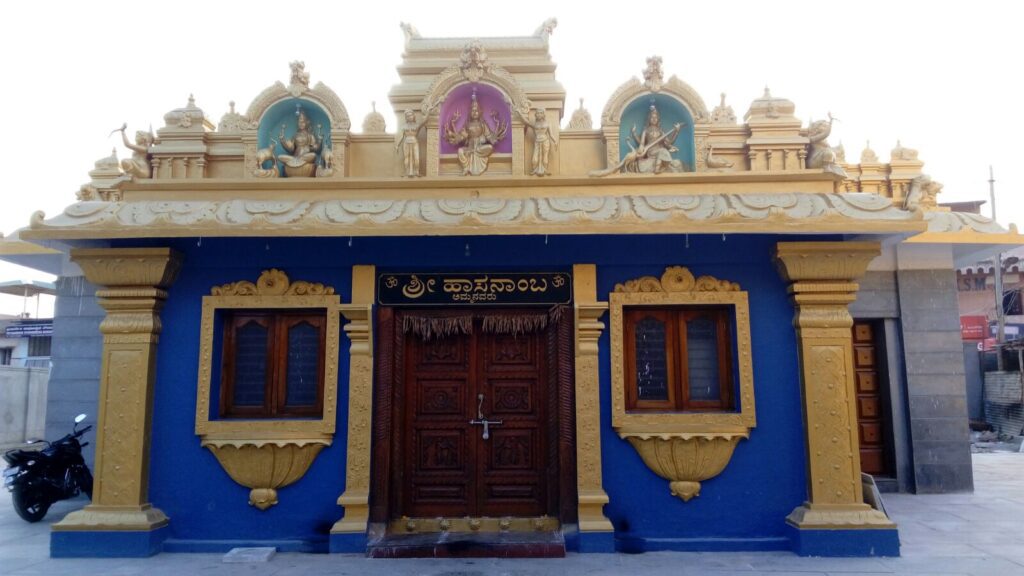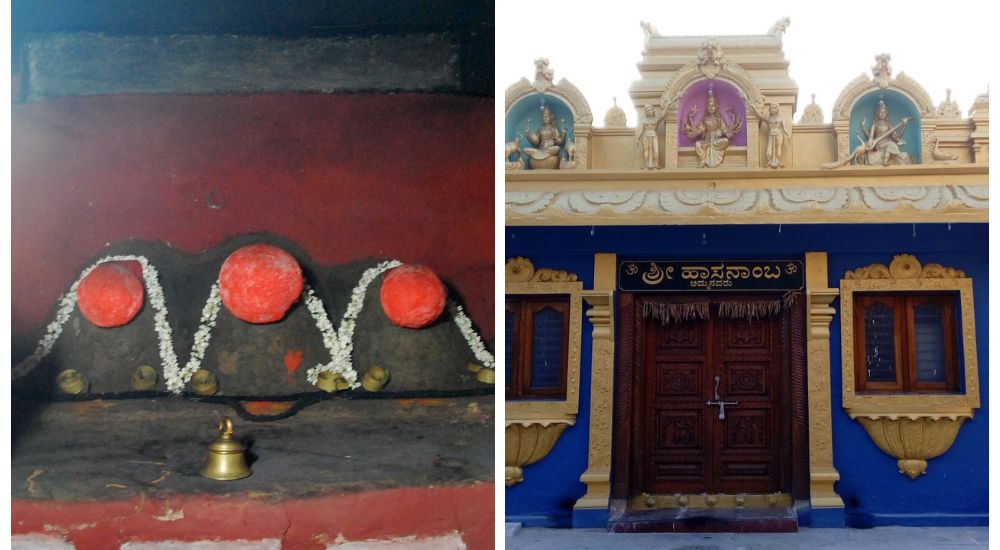Hasanamba Temple is an ancient Hindu temple located in Hassan, Karnataka. Dedicated to the Goddess Hasanamba, the Temple has a long and fascinating history. Visitors come from all over India to pay their respects to the Goddess and experience her spiritual presence. This temple guide will provide information about the Temple’s history, legend, darshan time, how to reach it, and its festival information.
| Temple Name | Hasanamba Temple |
| Temple is also known as | Hasanamba Amba Temple |
| Temple Dedicated to | Durga Mata |
| Temple Timing | 6:00 AM to 1:00 PM & 3:00 PM to 10:30 PM |
| Aarti | Durga Aarti |
| Darshan Fee | Free |
| VIP Entry | Available |
| Live Darshan | Not available |
| Important Festivals | Navratri, Diwali |
| Address | Hosaline Rd, Ammeer Mohalla, Hassan, Karnataka 573201 |
| Official Website | https://hassan.nic.in/en/tourist-place/hasanamba-temple/ |
| Contact Number | +91-08172-268862 |
| Official Email ID | Not available |
About Hasanamba Temple

Hasanamba Temple was built before the 12th century. There is an anthill representing the presiding deity within the temple grounds. As the Temple is only accessible for one week per year, it is considered a privilege to receive a darshan during the Deepavali celebration.
Archaeological scholars consider the Hasanamba Temple the pinnacle of Karnataka’s temple architecture. It was originally constructed by the Hoysala dynasty following their tradition and Jainism. The city of Hassan goes back to the 11th century, and the surrounding temples represent the kingdoms that have governed since then. The Hassan district’s temples represent the Hoysala style of temple architecture.
The seven Maatrukes (Brahmi, Maheshwari, Kaumari, Vyshnavi, Varahi, Indrani, and Chamundi) were amazed by the beauty of Hassan and chose to make it their permanent home. Maheshwari, Kaumari, and Vyshnavi inhabited the three anthills within the Temple; Brahmi inhabited Kenchamma’s Hoskote; Indrani, Varahi, and Chamundi picked the three wells in Devigere Honda.
Hassan was called after the deity that presided at the Hasanamba Temple. She is known as Hasanamba because she always smiles and bestows all wealth upon her believers.
While she is revered for her goodwill, she is cruel to those who choose to harm her followers. It is believed that Amma Hasanamba transformed a mother-in-law who tortured a devotee of Devi into a stone in front of her. According to popular belief, the age of Kali Yuga will end when the stone reaches the lotus feet of Hasanamba.
| Other Famous Temples of Karnataka | Other Famous Temples of Ambe Maa |
| Ragigudda Sri Prasanna Anjaneyaswamy Temple | Gabbar Ambaji Mata Mandir, Gujarat |
| Sri Srikanteshwara Temple, Nanjangud | Shri Shantadurga Temple, Goa |
| ISKCON Temple, Bangalore | Chettikulangara Temple, Kerala |
Legend of Temple
According to local folklore, long ago, there was a demon named Andhakasura who, after extensive penance, received a boon from Brahma that enabled him to become invincible. He wreaks devastation everywhere with his newly gained power. Every drop of his blood that falls to the ground transforms into an uncontrollable monster, even when Shiva attempts to kill him.
Shiva, by his powers, produces Goddess Yogeshwari, who, along with the other Saptamatrikas — Brahmi, Maheshwari, Kaumari, Vaishnavi, Varahi, Indrani, and Chamundi — destroys the demon.
Afterward, Saptamatrikas traveling south from Varanasi come upon a pristinely beautiful jungle and decide to settle there. This stunning area is where the modern city of Hassan was established.
Vaishnavi, Maheshwari, and Kaumari dwell in the anthill in the main sanctum sanctorum among the goddesses. Goddesses Chamundi, Varahi, and Indrani opted to stay in Devigere Tank next to the Temple, whereas Goddess Brahmi chose to reside in Kenchammana Hoskote.
History of Temple
In addition to Hasanmaba, temples are dedicated to Ganapati and Siddeshwara. It is stated that Hassan was formerly known as Sihmasanapuri and only much later adopted this name. During the reign of the Hoysala in the 12th century A.D., it is thought that Hasana Mukhi, an idol with a lovely, smiling countenance, was discovered. This was later regarded as Hassan’s presiding deity, and the name was altered. This is the mythology of Hassanamba Temple.
The seven maatrukes, Brahmi, Kaumari, Maheshwari, Vyshnavi, Indrani, Varahi, and Chamundi, arrived in South India and then Hassan. They fell in love with the beauty of this location and chose to make it their home: Vyshnavi, Kaumari, and Maheswari made their homes on three anthills within the Temple. Indrani, Chamundi, and Varahi selected Devigere Honda, while Brahmi chose Hosakote as his residence. The town was called after the Goddess who presided over the Hasanamba Temple.
According to another legend, Hasanamna transformed a mother-in-law abusing her daughter-in-law (a follower of the Goddess) into a stone. According to popular belief, the stone moves each year slightly. According to tradition, when the stones reach Hasanamba’s feet, the Kaliyuga will end. Four thieves attempted to steal gems from Hasanamba, but the Goddess changed them into the stones seen at Kallappa Gudi.
Hasanamba Temple Architecture
The architecture of the temples provides information about the several dynasties that controlled the region. The Temple of Hasanamba exemplifies the magnificence of Hoysala architecture. The temples constructed during the time of the Hoysalas had a distinct character. This was also constructed by a Hoysala dynasty ruler who was a Jainist and adhered to their customs.
The Temple is believed to have been constructed about the 12th century and is a superb example of Temple architecture from that era. The picture of Ravana with nine heads as opposed to 10 while playing the Veena is one of the most noteworthy features of this Temple. The entrance of the Temple provides a glimpse of the Siddeswara Temple, a rare feature. It depicts the three deities Brahma, Vishnu, and Maheshwara.
Religious Significance
A peculiar aspect of the Temple is that it is only open to the public for one week per year. For the remainder of the year, a lit lamp, food, two rice-filled bags, and flowers are offered to the Goddess.
The ghee-lit lamp, also known as Nanda Deepa, burns on the side of the Goddess 365 days a year to ensure that it never runs out, even while the Temple is closed. Additionally, the rice sacks presented to the Goddess are amazingly warm and unspoiled throughout the year. This makes it abundantly evident that it is one of the greatest temples in the neighborhood and attracts worshippers from all over the world.
Festivals at Hasanamab Temple
The Hasanamba Hatra Mahotsava, which takes place during the month of Deepavali, is one of the most well-known events held at this Temple. The festival will be held this year from October 13 to October 27. During the Ashwayuja month on the Hindu calendar, this is when the historic Temple is open to worshippers.
During this time, the Goddess is worshipped with a lit lamp, rice, flowers, and food that will be used for the rest of the year. Nanda Deepa is the name of the lamp that is lit with ghee. Even though the Temple doors are closed, the lamp is always lit, which is a beautiful sight. People believe the lamp will stay on all year and the rice bags will not go bad. Even the flowers that are put out stay fresh.
Darshan Timings
During Diwali, the Hasanamba Temple in Karnataka opens on the Thursday following Ashwin Purnima and shuts on Balipadayami eight days later, following the ancient Hindu calendar.
| Temple Time | |
| Morning Time | 6:00 AM to 1:00 PM |
| Evening Time | 3:00 PM to 10:30 PM |
Darsan Dresscode
When visiting a temple, men should avoid wearing shorts and generally dress modestly.
Local Culture
Hassan has contributed significantly to developing Kannada literature, art, and culture throughout the ages. Hassan has a predominant folk culture. Due to its proximity to Kodagu, Dakshina, Kannada, and Mysore, Hassan is a blend of these regions. This region is noted for its Kadabu (rice balls), Avalakki, also known as Poha in the rest of India, and Mandakki (similar to Bhel Puri).
The Mahamastakabhisheka is a magnificent Jain celebration conducted once every twelve years in Shravanabelagola when the statue of Bahubali is washed in milk, saffron, and other substances is a major attraction in Hassan. Additionally, shopping for minor artifacts, handicrafts, and jewelry is popular in Hassan.
Best Time to Visit
Winter is the greatest season to visit this shrine. September through February are the ideal travel months.
How to Reach Temple
By Air
People can fly to Mangalore, the nearest city to the Temple, and it is connected to nearly all of the world’s major airlines.
By Road
Hassan is connected to all major cities via well-constructed roadways. Hassan is only 115 kilometers from Mysore, 186 km from Bangalore, 172 km from Mangalore, and 65 km from Chikmagalur.
By Train
The closest train station to the shrine is Arsikere. It is 38 kilometers away. It has rail connections to several cities and locations in India.
Location Map
Quick FAQ – Hasanamba Temple
What is the Hasanamba Temple’s story?
It is believed that Amma Hasanamba transformed a mother-in-law who tortured a devotee of Devi into a stone in front of her. According to popular belief, the age of Kali Yuga will end when the stone reaches the lotus feet of Hasanamba.
What are Hasanamba temple timings?
During Diwali, the temple is open to the public for one week each year in the month of Ashwayuja (October). The darshan hours are from 7:00 a.m. to 1:00 p.m. and from 3:00 p.m. to 10:00 p.m.
What is Bangalore to Hasanamba temple distance?
The train journey time between Bengaluru and Hasanamba temple is around 3h 5m and covers a distance of around 185 km.

